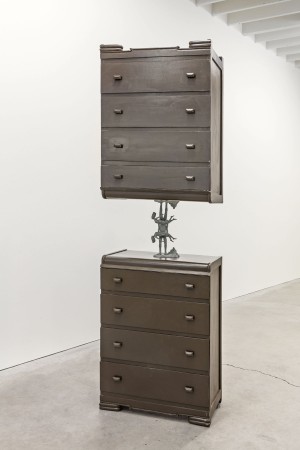31 March to 14 May 2016

Kunstkabinett, Kunstkammer, Wunderkammer, wonder-rooms, Cabinets of Wonder, or Cabinets of curiosities, came into popularity during sixteenth century Europe. Following a period of increased travel and imperial expansion, these deceivingly titled “cabinets” were actually rooms that functioned as mini-museums, that supported the growth of scientific knowledge. One of the earliest depictions of such a cabinet is Ferrante Imperato’s 1559 engraving published in Dell’Historia Naturale. In the image the cabinetter guides three visitor’s attention to the ceiling which is populated by an abundance of exotic creatures looming precariously above their spectators. Surprise is evident on the visitors faces, but what remains interesting to a contemporary viewer is the spectacle of blurred fact and fiction.
The space between fact and fiction has been an on-going point of inquiry for Kevin Yates, whose oeuvre has continued to build upon themes of simulation and experience. More specifically, Yates re-contextualizes familiar objects in a way that removes their use-value from our expectations. What at one moment are objects recognized and understood, are translated by Yates into the unknown or the unfamiliar. Likewise interested in the metaphorical weightiness of cabinets, Yates’s stacked and inverted dressers are no longer places to store things or hide secrets, leaving to question: what is inside? With a cinematic-like suspense, this looming interiority keeps the viewer in uncertainty of an unknown event.
In between the stacked pair of dressers is a figurine-like object – much like what might be found on an actual dresser – that creates an unresolved pause. Like a shelf, the interior space acts as a site of display. Similar to the microcosms of the world purported by the cabinets of curiosities, association with this item elicits a metaphorical reading contingent upon each individual’s prior knowledge or experience.
Upstairs a stack of cast bronze flashlights flicker and spill a warm glow. The beam of a flashlight might provide a sense of safety, illuminating darkness and revealing the previously unknown to a viewer’s gaze. Similarly, perhaps, through the acts of metaphorical doubling and inversion Yates implicates us in the reading of his work; to entangle our own antecedent experiences in a dimly lit place between fact and fiction.

